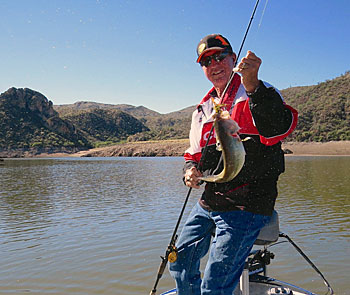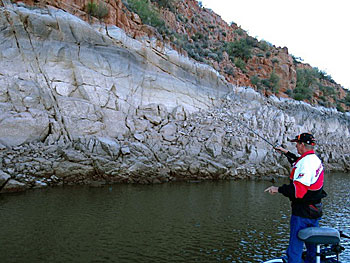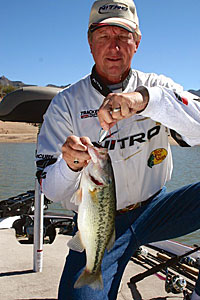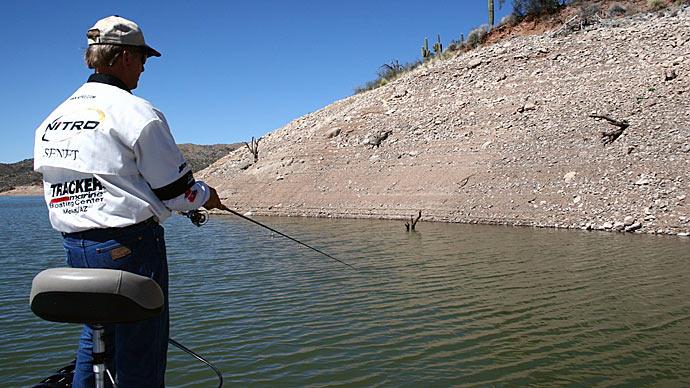
Out west, bass fishermen are at the mercy of the powers that control the lake levels. Western reservoirs exist first and foremost to supply water to ever-growing, thirsty populations, including water needed for agriculture. Out here, falling and rising waters are a given, and the best bass fishermen have learned to deal with it. On our lakes, drawdowns of 100 vertical feet per year are not unusual, and with luck, the water will rise that much during the winter.
Rising Water
Right now, at Bartlett Lake northeast of Phoenix, the water rises about a foot a day, contrary to the usual pattern of water levels falling during the summer. This rising water is spreading out fish, especially in the river, says Bass Pro Shops pro Gary Senft. Senft not only fishes a variety of tournaments on Arizona waters, but he also guides on Bartlett, so he needs to find fish on a daily basis. This rising water is particularly affecting the fish in the lake's shallow or river end, so Senft concentrates on fishing the main lake.

The water is warm in the summer – 80 degrees - even though the water rises fast, the fish aren’t spending much time up shallow. These fish get stressed if they try to live in warm and shallow water.
However, Senft discovered he could catch a many small fish in the shallows. The bigger fish are located slightly deeper and related to giant boulders where the water is cooler. He started catching the bigger ones once he started fishing craw baits slowly past these boulders, very close to the big rocks.
“One of the things you need to know if you’re going to be a successful bass fisherman is how different water conditions affect the stuff the bass eat,” Senft said. In other words, to find the predator, find the prey. Out west, the prey is mostly crawfish and shad. The crawfish on Bartlett are moving up with the water. Since crawfish are most active at night, starting at dusk, Senft finds success during the night at Bartlett.
The angler loves to tinker with his fishing rigs. For instance, he uses bobber stoppers to position the hook on his dropshot rigs and ties the weight with at least three knots. This allows the hook to slide down to the sinker, and the line doesn’t get tangled.
He’s also developed a new way to rig a mini Carolina or split shot rig. He ties a swivel to the end of his line, then attaches a 4-inch leader with a cylindrical dropshot weight tied at the end. He ties at least three knots to the dropshot weight to help it stay on when he has to tug the rig out of the rocks. He then ties an 18- to 24-inch leader of 8- to 10-pound-test XPS fluorocarbon line to that same weight. The 1/0 hook is at the end of this leader. This rig has been producing a lot of good bass for him in this rapidly rising water. Gary also fishes craw baits on a Texas rig, using a bobber stopper to keep the weight about two inches away from the hook.
The craws he uses are Yum Christie Critters in Watermelon Candy. Senft emphasizes that you need to know what color the craws are at your lake and choose the bait accordingly. If the fish are biting short, he’ll bite off the front inch or so of the bait, just ahead of the flappers, and fish with the tiny bait. He drags the rig slowly down the bank because craws themselves move slowly. If they are scared, they will use that tail to send themselves flying backward through the water fast, but they don’t naturally go around fast all the time. Most of the time, they are just moving along slowly, looking for stuff to eat on the bottom.
For the most part, when the water moves up, the fish move up almost as quickly. But you also have to consider water temperature.
Falling Water
Falling water often draws bass away from shore and toward deeper holes, but not always. On flats, when the water starts to leave, the crawlers also have to leave. You’ll often spot big shorebirds feasting on craws in very shallow water on flats because the craws are forced to come out in the daytime to avoid being left high and dry. In this case, bass will be almost incredibly shallow, because the eating is too good to pass up. Don’t get locked into someone else’s idea of what fish are doing – make some of your observations.

Falling water can influence shad. Sometimes it makes them suspend over deep water in the middle of the lake. I’ve known guys to catch fish on topwater in the middle of a hot summer day over 200 feet of water. Gary says falling water can also suspend the bass, so he’ll often try fishing vertical structures, pilings, and submerged trees.
Last fall at Bartlett, the water fell six inches a day, and Gary was finding bass on steep rocky banks, catching them on shad or craw-colored spinnerbaits and crankbaits. Even though the water was falling, the bass were close to shore on these steeper banks because the dropping water was forcing the crawdads to relocate, and the cooler water – 57 degrees that time of year – was letting the shad stay shallow. He pitches the lure up shallow on these rocky banks, aiming for a quiet entry.
Once the early morning bite slows down, Gary moves out to deeper holes and fishes the outer quarter of coves and submerged humps (these are a bonanza, mainly if they aren’t buoyed, so not many people know they are there). He checks channels in the larger coves because falling water will funnel the bass into these channels. Points right outside coves are great spots to try as well. The narrow side channels can be an excellent spot – if you don’t have a graph that shows you a lake map, you can locate these little feeder channels by observing the shoreline. Out west, creeks rarely have water in them, but you can still see where water runs during the rainy seasons.
How deep should you be fishing when the water is falling? One way to know is to look at your graph. There will usually be one range with a lot of clutter. This is the area around the thermocline where the action is. Finding structure at this depth is ideal. Gary will throw a craw or creature bait up to shore even in falling water conditions, then work it back to deeper water. He’ll always start fishing fast; if that doesn’t work, he slows down. Once he catches a few fish, he has a pretty good idea of what and how he should fish.
Rising or falling water can move the fish but won’t move them out of the lake. Hopefully, these tips from Senft will help you find bass even when the water levels are rapidly changing. If you’d like to see more tips from Gary, he has a YouTube channel: Fishing with Gary Senft.
***********************************
You love bass fishing, and you’re a catch and release guy, but you may be doing more harm than you know:
How To Kill A Bass Even If You're Releasing It
1. Drop it on the carpet of your boat. This removes the slime coating and makes the fish susceptible to various pests and diseases.
2. Keep it out of the water for prolonged periods so you can take killer selfies. How long can you hold your breath?
3. At the weigh-in, keep just a little water in the bag, then stand in line for quite a while. The oxygen in that water will be used up pretty darn quick.
4. Catch him deep. Even “fizzing” doesn’t save a deep-caught fish. Fizzing only punches a hole in their swim bladder so they can go back down. But the air in their swim bladder is only part of the problem. The dissolved air in their organs and tissues also expands, causing hemorrhaging that's almost always fatal.
BassResource may receive a portion of revenues if you make a purchase using a link above.




